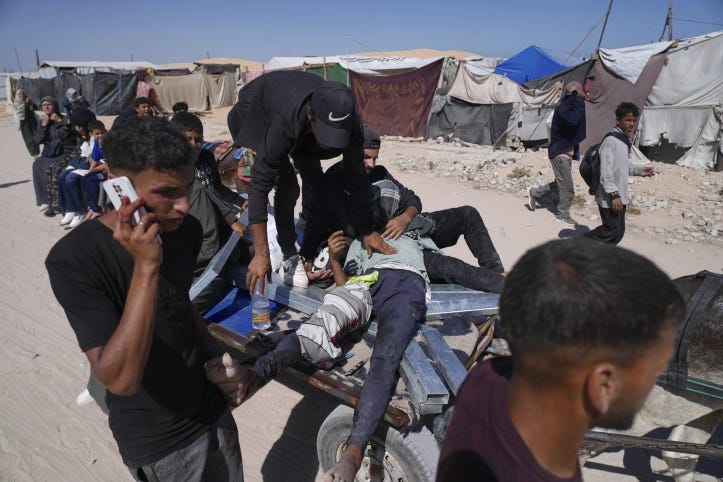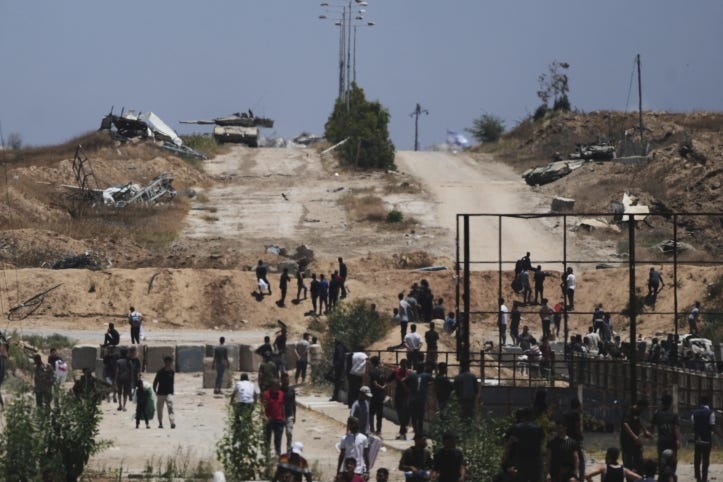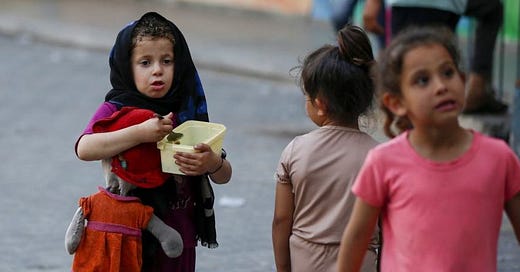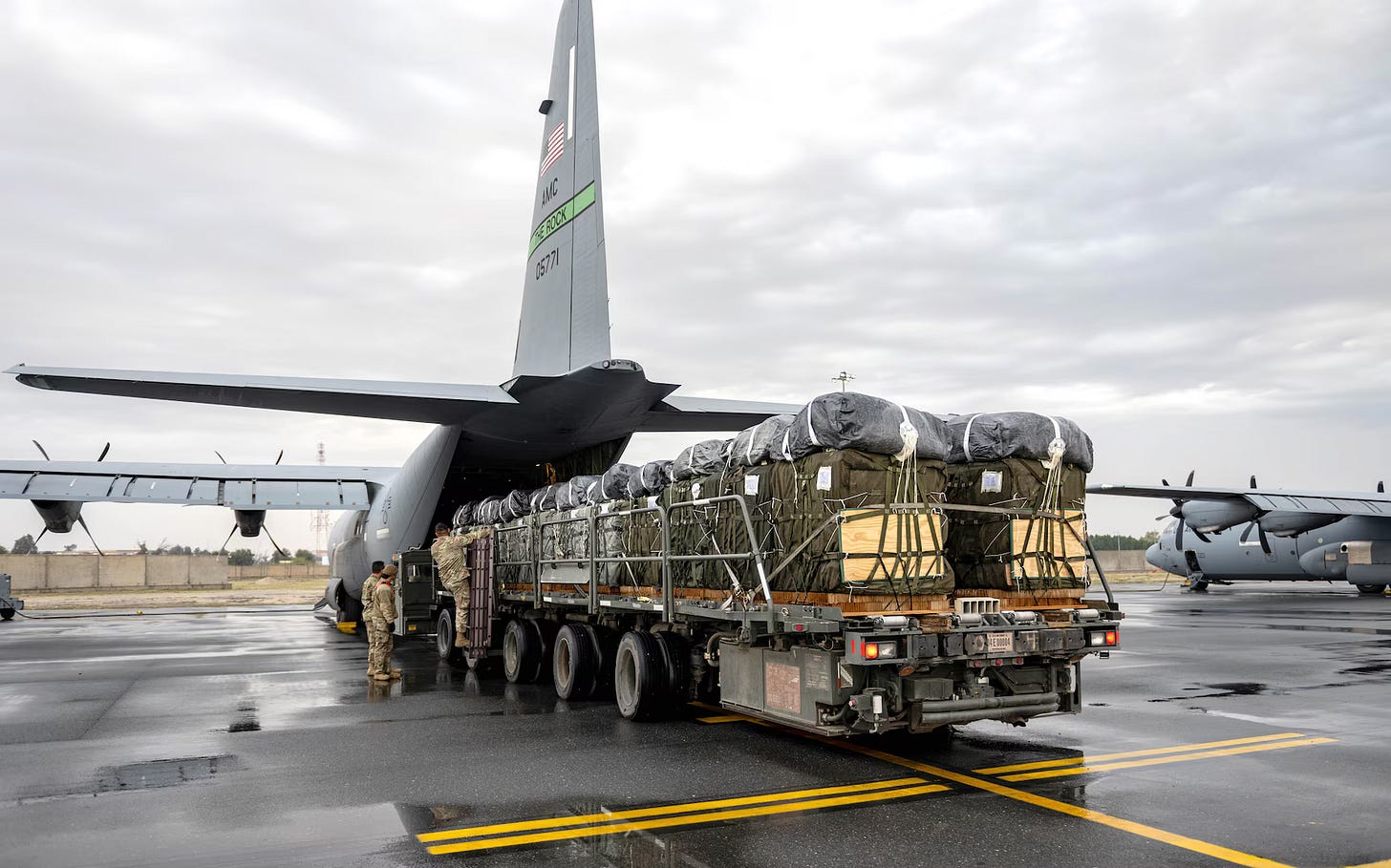How to deliver food to Gaza: Let’s count the ways.
Last year the US floated (literally) the idea of food drops from the air over Gaza. By March 2024, there had been 11 food drops, each dropping 35,700 ready-to-eat meals and 31,800 bottles of water. The problem was that people could not reach the food parcels, many were injured as people rushed to catch the stashes. At the time, there were more than 2.5 million in Gaza in need of food since Israel has refused to allow most aid from food to medicine to other essentials. But the US believed that dropping 35,000 meals – enough to give one lunch to 1.4% of the Palestinians –would somehow do the trick.
Then there was the pier, remember that? The US built a $230 million pier from Gaza into the Mediterranean that the US had to dismantle after barely two months in service. The pier was to allow for aid to come by ship into Gaza— but critics noted that instead of using the pier to offload aid, Israel had to be pressured to open land borders for aid trucks to enter. Quite simply, trucks carried far more aid and were able to distribute it more widely than a sea drop off. At the time, in July 2024, 96% of Palestinians were food insecure and one in five faced starvation.
In the first 10 days of June 2025, of the UN’s 139 planned aid deliveries across Gaza coordinated with Israeli authorities, 72 were denied, nine impeded, 18 withdrawn, and 40 facilitated. Overall, of the 139 arranged food deliveries, Israel allowed only 28% through. And the people are starving.
2025 Pulitzer prize winning author Palestinian Mosab Abu Toha wrote recently in The New Yorker about what his relatives in Gaza tell him about food in video-calls He spoke to his uncle in Beit Lahia, in northern Gaza, where Toha and his wife Maram grew up. On his mobile phone screen, Toha saw his uncle, aunt and four adult children sitting to eat, plus empty plates piled nearby. The meal consisted of one scoop of plain, white rice for each of the six — “That’s the only type of food we’ve had for weeks,” said the uncle. “We let ourselves imagine there is salad and some chicken and pickles as we chew the rice.”
Toa contacted an aunt in Gaza City who lived in a tent on the street. There was the sound of digging in the background to his video call.
In Gaza- Palestinians burn asphalt to cook food
“Your Uncle Jaleel is hammering at the asphalt,” she explained. I was shocked when she explained why: they were burning it to cook food. “We ran out of wood and paper,” Aunt Iman said. “The asphalt contains petroleum.” Her skin looked dark from exposure to heat and soot.
I asked her if they had received any food recently. “Nothing at all,” she told me.
“Not even from the Gaza Humanitarian Foundation?”
“Nothing,” she said.”
Delivering aid never killed anyone— before now
The Gaza Humanitarian Foundation (GHF) is an Israel-US-backed food charity that Israel has used to elbow out all aid, including food aid for the millions of starving Palestinians, from UN agencies and Palestinian-friendly NGOs. Aid given by professional charitable organizations during Israel’s 18-year siege of Gaza helped Palestinians survive – the delivery of aid never killed anyone before now.
However, GHF’s distribution has destroyed thousands of Palestinians’ lives—and GHF has only been distributing food aid for four weeks. During that time, IDF snipers have shot dead more than 400 Palestinians and seriously wounded another 1858 at the five food distribution sites the IDF set up in Gaza, where tens of thousands had gathered to get seek food aid. Israeli snipers regularly shoot and kill the starving Gazans who are waiting for food.
Gaza food aid is a “death trap”
Early in June, Reem Zeidan, a 42 year old mother of eight, walked overnight with two of her children from their tent in Khan Younis to Rafah – 9 km –to get to a GHF food distribution site by dawn. The family stopped at a rest stop to nap. Zeidan’s son Ahmad,12, witnessed this:
“Suddenly, the snipers started shooting. The artillery began shelling. The tanks were firing too,” Ahmad said. He heard drones and quadcopters hovering overhead. “There was nothing left untouched, not even the sea. They were bombing there too.”
An Israeli sniper or drone killed Zeidan. She was one of 30 Palestinians killed for trying to get food– in Zeidan’s case a mere bag of flour — on 3 June.

Yesterday 46 people were shot and killed when Israeli forces opened fire as Palestinians approached the aid truck at two food stations.
As UNRWA Commissioner-General Philippe Lazzarini posted on X,
“Day after day, casualties and scores of injured are reported at distribution points manned by Israel and private security companies.” Not only did this “humiliating system” force thousands of hungry and desperate people to walk very long distances, “excluding the most vulnerable and those living too far… [the] system does not intend to address hunger.”

How much food has the GHF actually distributed? One source claims GHF delivered nearly nine million meals — or enough to feed 2.3 million Gazans only two and a half meals.
To break the siege of Gaza, earlier in June, 12 people including Swedish activist Greta Thunberg, travelled aboard the boat the Madleen from Sicily to Gaza. They did this to bring food and supplies to Gaza—but more to draw the world’s attention to the starving Palestinians. In international waters, the IDF boarded the vessel and commandeered it to an Israeli port. While Thunberg, a world-famous environmentalist, was sent back to Sweden, three members of the crew remain illegally jailed in Israeli prisons, and could be held for another month. Support groups have demanded the French and Dutch governments call for their citizens’ release.
Global March to Gaza
Recently 4,000 activists from 80 countries massed in Cairo to begin the Global March to Gaza. The plan was to march or take a convoy the 319 km to Gaza’s Rafah crossing to demand an end to Israel’s siege, but Egypt has harassed and arrested marchers— because Egypt doesn’t want to upset Israel.
The genocide against Palestinians is live-streamed 24/7 — it is no “conflict” or “war” as the Zionists and the western media like to say. Starvation – and the deaths from starvation – are there for all to see.
Image at the top: People who have taken refuge in school run by the UN agency for Palestinians (UNRWA) in Deir al-Balah in central Gaza are struggling to survive as they lack access to basic humanitarian needs. Note the girl carrying her doll. Latest data simulations from the Food and Agriculture Organization (FAO) point to the average Gazan eating just 1,400 calories per day – “or 67 per cent of what a human body needs to survive” (2,300 calories) as of May. (photo credit: © UNRWA)
Share this:
Related
“We ate the donkey’s corn and barley.” Happy International Women’s DayMarch 8, 2024In "Arabs"
On Palestine…Oct. 31October 31, 2023In "Arabs"
Death from afar vs death up closeMay 22, 2025In "Abu Akleh"
Post navigation
PreviousBe on the Right Side of History
Leave a comment
Write a comment...




